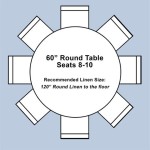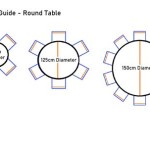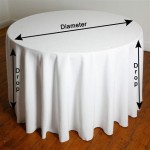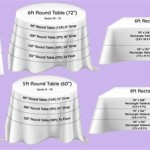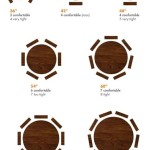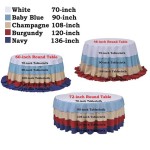Circle Dining Table Set Up: A Guide to Elegance and Functionality
A circle dining table, with its unique shape and evocative symbolism, can be a captivating centerpiece in any dining room. Its graceful curves invite a sense of intimacy and encourage open communication among diners, making it an excellent choice for families and gatherings. However, setting a circle dining table requires some consideration to ensure both aesthetic appeal and practical functionality. This guide will explore the essential elements of circle dining table setup, covering tablecloths, chair placement, and the art of creating a balanced and inviting dining experience.
Tablecloths: Adding a Layer of Sophistication
A tablecloth is the foundation for a well-dressed dining table, adding a touch of elegance and protecting the surface from spills and scratches. When choosing a tablecloth for a circle table, consider its size and drape. The ideal tablecloth should hang approximately 12 inches beyond the edge of the table, creating a graceful cascade. For a more formal occasion, opt for a crisp white tablecloth with intricately woven designs or embroidered details. For a casual setting, a solid-colored linen tablecloth in a warm hue or a playful patterned fabric will add a touch of personality.
When laying the tablecloth, ensure it is perfectly centered and smoothed out to prevent any wrinkles or bumps. If you're using a table runner, place it lengthwise down the center of the table, centered with the tablecloth. Table runners can add textural interest and highlight the circular form of the table. The runner can be a contrasting color or pattern to the tablecloth or match the theme of the occasion.
Chair Placement: Creating a Harmonious Flow
The placement of chairs around a circle dining table is crucial for both functionality and aesthetics. Aim for an even distribution of chairs, ensuring ample space for comfortable seating and easy movement. Consider the size of the table and the number of guests you typically host. A general rule of thumb is to allow 24-30 inches of space per person, allowing for comfortable armrests and enough room for plates and silverware.
For a formal setting, place chairs equidistantly around the table with the backs aligned. In casual settings, chairs can be placed slightly off-center to create a more relaxed and inviting atmosphere. Consider using chairs with different styles and textures to add visual interest. For example, a mix of wooden and upholstered chairs can create a unique and stylish look.
Table Setting: Balancing Functionality and Beauty
The art of table setting is an opportunity to express personal style and create a harmonious visual experience. When setting a circular table, consider the following elements:
Placemats: Placemats provide a protective layer for the tablecloth and add visual interest to the table setting. Choose placemats that complement the tablecloth, table runner, or the overall theme of the occasion. For a formal setting, use solid-colored placemats in a neutral hue or a simple geometric pattern. For a casual setting, consider placemats with textured patterns or natural materials such as woven bamboo.
Dinner Plates: Dinner plates should be placed at a distance of approximately 2 inches from the edge of the table. If you're using chargers, they should be placed first, with the dinner plate placed on top. The dinner plate should be centered on the placemat, creating a foundation for the rest of the table setting.
Flatware: Flatware should be placed in a logical order based on the sequence of courses in your meal. The fork is placed to the left of the plate, the knife to the right, and the spoon to the right of the knife. For a multi-course meal, additional silverware can be placed on the table, with the utensils for the first course placed closest to the plate. For a four-course meal, the fork for the salad course would be placed furthest from the plate, followed by the fork for the main course, and then the dinner fork. If a soup course is served, a soup spoon should be placed to the right of the knife.
Glasses: Glasses should be placed to the right of the knife, forming a diagonal line. The water glass is placed at the top of the diagonal line, with the wine glass placed below it. For a formal setting, a champagne flute could be added to the right of the wine glass.
Napkins: Napkins can be folded in various ways to add a touch of elegance to the table setting. For a formal setting, a folded napkin can be placed on the dinner plate or to the left of the fork. In a casual setting, a napkin can be folded into a simple square or rolled and placed in a napkin ring.
Centerpiece: A centerpiece is a focal point for the dining table, adding visual interest and creating a welcoming atmosphere. For a circle dining table, a centerpiece with a low profile is ideal, allowing for clear views across the table. Consider a floral arrangement, a bowl of fruit, or a collection of candles. The centerpiece should complement the overall theme of the occasion and create a sense of balance and harmony with the rest of the table setting.
Setting a circle dining table involves a thoughtful balance of functionality and aesthetics. By carefully considering the tablecloth, chair placement, and the elements of table setting, you can create a welcoming and elegant space for sharing meals and creating lasting memories with loved ones.

How To Set Up A Round Dining Table 5 Brabbu Design Forces

How To Decorate A Round Table

How To Set Up A Round Dining Table 1 Brabbu Design Forces

Blue And White Table Setting For Thanksgiving

Roundhill Furniture Arch Weathered Oak Dining Set Round Table Four Chairs

Furniture Of America Dorazio Wood 5 Piece Round Dining Table Set In White

Modern Heritage Shullden 5 Pieces Round Wooden Dining Set In Gray

Kamida Dining Table Set For 4 Modern 5 Piece Round With Extendable Kitchen Upholstered Chairs Farmhouse

5pc Dinette Kitchen Dining Set Round Pedestal Table 4 Parsons Chairs In Black

Ashley Express Centiar Round Dining Room Table Furniture Depot Inc Fayette
Related Posts

